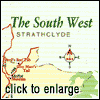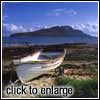|
Arran
The ferry terminal for the island of Arran, found
in Ardrossan, is well sign-posted. The town of Ardrossan itself does not have much
to recommend. Fill up with fuel before crossing. There are filling stations on the
island's main communities but they are more expensive. Bear in mind there is also
a summer ferry service from Lochranza on the north side of Arran to Claonaig on the
Kintyre peninsula, so it is possible to continue on to a tour of the Kintyre area
from Arran.
 Arran is the most southerly of the Scottish islands. The Highland
Boundary Fault, which passes from Stonehaven to Helensburgh dividing Scotland into
the Highlands and the Lowlands, continues through Arran, effectively slicing it in
half. The ball-of-wool shaped land-mass is only 56 miles (90km) around the edges,
so it is easy to circumnavigate by car during a day-visit. Arran is the most southerly of the Scottish islands. The Highland
Boundary Fault, which passes from Stonehaven to Helensburgh dividing Scotland into
the Highlands and the Lowlands, continues through Arran, effectively slicing it in
half. The ball-of-wool shaped land-mass is only 56 miles (90km) around the edges,
so it is easy to circumnavigate by car during a day-visit.
The south side
Brodick is Arran's largest population centre. Its
wide beach extends around Brodick Bay. Its location at the mid-point of the east
coast of the island makes it a good base for exploring further afield. There are
a few gift shops and a Tourist Information Office situated near the pier.
The town's main tourist attraction is Brodick Castle
overlooking Brodick Bay. The earliest portions of this kidney-coloured, sandstone
pile date back to the thirteenth century although a Viking fort previously stood
on the site. The contents are worth seeing particularly the superb silverware, porcelain
and sporting trophies.
Returning to the town of Brodick, the Isle of Arran
Heritage Museum is on the left just before entering the town, an eighteenth century
croft farm. The interior displays give an insight into the islander's way of life
for several centuries with artefacts set in an old smiddy and stable block. The nearby
cottage contains a variety of items from around World War I. There are several good
retail outlets here.
South of Brodick, the neighbouring hamlet of Lamlash
is only 3 miles (5km) away. As you descend the hill into Lamlash you can appreciate
the splendid view across Lamlash Golf Course and Bay to Holy Island. It was in this
sheltered bay that the Viking King Hakon returned after his woeful defeat at Largs.
 Holy Island has been purchased as a Buddhist retreat and is
not open to the public. Lamlash is a fairly secluded little village, ideal for a
restful stay with sea-angling or strolling the main occupations unless some folk
entertainment is arranged in one of the several welcoming pubs such as Andy's Place. Holy Island has been purchased as a Buddhist retreat and is
not open to the public. Lamlash is a fairly secluded little village, ideal for a
restful stay with sea-angling or strolling the main occupations unless some folk
entertainment is arranged in one of the several welcoming pubs such as Andy's Place.
Whiting Bay, the southernmost of Arran's three main
east coast villages, appeals to keen fishermen but make note that there is no fishing
on Sundays. It is also a popular holiday village with cottages and hotel rooms for
rent. Facilities are plentiful but it perhaps lacks the repose of other Arran locations.
Kildonan, on the southern tip, is more rustic. There
are the ruined medieval Kildonan Castle standing out on a craggy spit, sandy beaches,
and views of the tiny island of Pladda with its lighthouse and the Christmas pudding
shape of Ailsa Craig on the horizon. Colonies of seals inhabit the more remote rocky
shoreline.
The west side
The villages of Lagg, Sliddery and Corrie Cravie on
the south-western side are noted for their tropical vegetation due to the warming
effects of the Gulf Stream. The Lagg Hotel in Kilmory has one of the best restaurants
on the island and is also very comfortable to stay in.
 The village of Blackwaterfoot is less a resort and more a
genuine Hebridean fishing village. Visitors here for a few days seem to enjoy this
side of the island for its fresh breezes and refreshing views over to the Kintyre
Peninsula. Two miles (3km) north of the village past the unusual and highly regarded
12-hole Shiskine golf course is King's Cave where Robert the Bruce supposedly watched
the spider which inspired him for future battles against the English. The village of Blackwaterfoot is less a resort and more a
genuine Hebridean fishing village. Visitors here for a few days seem to enjoy this
side of the island for its fresh breezes and refreshing views over to the Kintyre
Peninsula. Two miles (3km) north of the village past the unusual and highly regarded
12-hole Shiskine golf course is King's Cave where Robert the Bruce supposedly watched
the spider which inspired him for future battles against the English.
It is possible to take the String Road, the B880 directly
back to Brodick from Blackwaterfoot, but the circular tour continues following the
coast road north. On the desolate Machrie Moor and around the abandoned steadings
of Moss Farm just north of Blackwaterfoot is a remarkable collection of stone circles
and cairns from the Neolithic and Bronze Ages.
The North
The omnipresent peak of Goat Fell looms larger as
you near the island's north tip following the coastal route overlooking the Kilbrannan
Sound to the Mull of Kintyre. Entrance to the village of Lochranza is heralded by
a string of colourful cottages called the 'twelve apostles,' perhaps best appreciated
from the ferry which sails between here and Cloanig on Kintyre during the summer.
Set out near the tidal flats is the ruin of Lochranza
Castle made famous by Sir Walter Scott in the Lord of the Isles. Lochranza Golf Club
is famous for the red deer stags that frequent its fairways, chewing on the sweet,
pesticide-free grass. Golden Eagles are sometimes seen over the village.
The Isle of Arran Distillery and Visitor Centre has
opened on the east side of the village and will take you through the whisky experience
with interactive displays and a 12 minute film.
From the route descending back south to Brodick, sweeping
slopes are appreciated and dominated by Goat Fell, the islands highest mountain.
This is good walking country and it is possible to scale Goat Fell in a day with
the right equipment and map which takes approximately 5 hours from the car park at
Cladach or Corrie.
Sannox Bay is a scattering of houses on the eastern
shore with a spectacular 9 hole golf course while the village of Corrie is a photographer
or artists delight, a band of adorable cottages overlooking the pebble beach and
a tiny inlet harbour.
|



